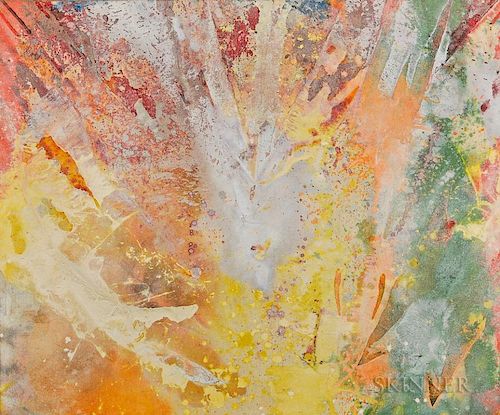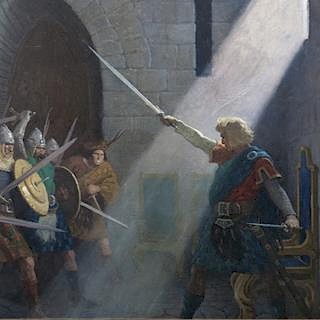Sam Gilliam (American, b. 1933) Yellow Fan-White Float
Lot 406
About Seller
Bonhams Skinner
274 Cedar Hill Street
Marlborough, MA 01752
United States
Founded over four decades ago, Bonhams Skinner offers more than 60 auctions annually. Bonhams Skinner auctions reach an international audience and showcase the unique, rare, and beautiful in dozens of categories, including the fine and decorative arts, jewelry, modern design, musical instruments, sc...Read more
Categories
Estimate:
$80,000 - $120,000
Absentee vs Live bid
Two ways to bid:
- Leave a max absentee bid and the platform will bid on your behalf up to your maximum bid during the live auction.
- Bid live during the auction and your bids will be submitted real-time to the auctioneer.
Bid Increments
| Price | Bid Increment |
|---|---|
| $0 | $10 |
| $100 | $25 |
| $500 | $50 |
| $1,000 | $100 |
| $3,000 | $250 |
| $5,000 | $500 |
| $10,000 | $1,000 |
| $30,000 | $2,500 |
| $50,000 | $5,000 |
| $100,000 | $10,000 |
| $300,000 | $25,000 |
| $500,000 | $50,000 |
| $1,000,000 | $100,000 |
About Auction
By Bonhams Skinner
Jan 26, 2018 - Jan 27, 2018
Set Reminder
2018-01-26 14:00:00
2018-01-27 14:00:00
America/New_York
Bidsquare
Bidsquare : Fine Paintings & Sculpture
https://www.bidsquare.com/auctions/skinner/fine-paintings-sculpture-2934
Bonhams Skinner bidsquare@bonhamsskinner.com
Bonhams Skinner bidsquare@bonhamsskinner.com
- Lot Description
Sam Gilliam (American, b. 1933)
Yellow Fan-White Float
Signed, dated, and titled "Sam Gilliam 73..." on the reverse.
Acrylic on canvas with beveled edge, 59 1/2 x 70 1/2 in. (151.0 x 179.0 cm), framed.
Condition: Drying cracks in areas of thicker paint, surface grime.
Provenance: A Rhode Island collection.
N.B. Born in Mississippi and raised in Kentucky, Sam Gilliam moved to Washington, DC, after graduating from college. By the 1960s, he had established himself as a member of the Washington Color School, alongside painters Kenneth Noland and Thomas Downing. Gilliam's experiments with paint application and his transformation of the canvas support elaborated upon the ideas and processes of Color Field painting.
Between 1967 and 1973, Gilliam focused on two series of works, one he called "Beveled-edge" or "Slice" paintings, the other he called "Drape" paintings. The present lot is a perfect example of a Beveled-edge work. For these paintings, he began by pouring acrylic paint (sometimes diluted) directly onto unprimed, unstretched canvases or by soaking the canvases in the paint, similar to techniques used by Helen Frankenthaler and Morris Louis. He would then manipulate the wet canvas--by folding, crumpling, hanging, or even shaking--to transform the washes of color into layers of ridges, grooves, drips, and pools of pigment. He achieved depth by layering the paint and building up the surface with a variety of textures. Finally, when the paint was dry, Gilliam stretched the canvases onto custom-made stretchers with beveled edges. When hung, the beveled edges projected the works off of the wall and towards the viewer, removing the image from the flat, two-dimensional plane of traditional painting and into the viewer's physical space. By varying his pouring and soaking techniques, Gilliam created a variety of compositional forms, ranging from vertical columns of color, to collage-like layers of diagonal folds, to radial bursts of light, all of which were shaped by a combination of carefully controlled processes and actions and by the inevitable element of chance.
The Drape paintings were made in much the same way; however, for these, Gilliam skipped the final step of stretching the canvases, and instead hung them from walls and ceilings without frames or supports, either draping, folding, or tying the final product. The Beveled-edge and Drape paintings were the focus of Gilliam's first New York solo gallery show in 32 years, at Mnuchin Gallery in the fall of 2017. Still working on Drape paintings today, Gilliam created the huge Yves Klein Blue for the 2017 Venice Biennale. The work took center stage, hanging above the entrance to the exhibition's Central Pavilion.
This was not the first time Gilliam participated in the Venice Biennale, he had also contributed to the American Pavilion in 1972. His works have been exhibited widely in galleries and museums worldwide. Upcoming exhibitions include The Music of Color: Sam Gilliam, 1967-1973 at the Kunstmuseum Basel, June 9-September 30, 2017 and Soul of a Nation: Art in the Age of Black Power, Crystal Bridges Museum of American Art, February 3-April 23, 2018 and the Brooklyn Museum, September 7, 2018-February 3, 2019.
Estimate $80,000-120,000
The absence of a condition statement does not imply that the lot is in perfect condition or completely free from wear and tear, imperfections or the effects of aging. Condition requests can be obtained via email (lot inquiry button) or by telephone to the appropriate gallery location (Boston/617.350.5400 or Marlborough/508.970.3000). Any condition statement given, as a courtesy to a client, is only an opinion and should not be treated as a statement of fact. Skinner Inc. shall have no responsibility for any error or omission. - Shipping Info
-
Please visit http://www.skinnerinc.com/services/payment-and-shipping/ for information regarding the collection of items purchased at auction.
-
- Buyer's Premium



 EUR
EUR CAD
CAD AUD
AUD GBP
GBP MXN
MXN HKD
HKD CNY
CNY MYR
MYR SEK
SEK SGD
SGD CHF
CHF THB
THB



















